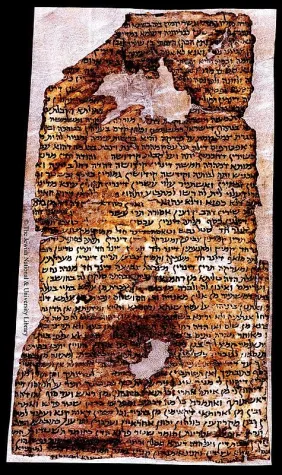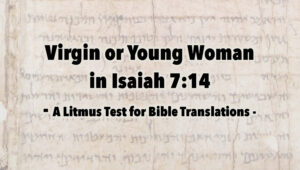Was Mary a Virgin When Gave Birth to Jesus?
Frankly, no one can prove Jesus was born of a virgin and neither can anyone disprove it. Basic human biology and common sense dictates a virgin cannot naturally conceive – a miracle would be required. Believing Mary was a virgin who miraculously conceived Jesus, if not by faith, requires a conclusion based on the circumstantial evidence.
Indirect evidence – circumstantial evidence – when combined together leads to an inference or conclusion of a fact. Direct evidence, on the other hand, lends itself to proving a fact.[1]
Jewish marriage was a two-stage process – first the legal betrothal period typically lasting for 12 months, then consummation at the actual wedding. To begin the process, a proposal by the groom was offered to the prospective bride’s father if she was not an adult.
Negotiated details were eventually formally finalized in a formal legal marriage contract called a ketubah. Enacted by Judean Queen Salome Alexandra (76-67 BC) and formalized by the Sanhedrin long before Joseph or Mary were born, it placed a deed on the groom’s property.[2]

Talmud Kethuboth addresses the ketubah – the price of a virgin or non-virgin; what constitutes virginity status; default recourses; etc. Two important components of a ketubah, in this instance, are virginity and witnesses.
Family intermediaries vetted the couple’s families, backgrounds and defined the terms of the contract. Financial details were negotiated including the bride price, the dowry, and any contributions from both families.
Monetary values for virgins and non-virgins were predefined by the Sanhedrin, the value of a virgin was twice that of a non-virgin stipulated in a ketubah document.[4] Two family intermediaries signed the ketubah as witnesses meaning the bride was confirmed to be a virgin.[3]
For the bride, the ketubah provided a trust fund in the event of the husband’s death or a divorce excepting for the disqualifying factor of adultery. For the groom, the ketubah factually and legally established his betrothal was a virgin.[5]
Details of the ketubah contract found in the Jewish Encyclopedia twice makes specific reference to the prospective bride’s virginity:[6]
…“And I will set aside for thee 200 zuz, in lieu of thy virginity, which belong to thee (according to the law of Moses)…”
…“We have followed the legal formality of symbolical delivery [“ḳinyan”] between _____ son of ______ , the bridegroom, and ______ daughter of ______ , this virgin, and have employed an instrument legally fit for the purpose to strengthen all that is stated above, and everything is valid and established.
…………..Bridegroom.
…………..
…………..Witnesses.[7]
During Mary’s betrothal, according to Luke, the angel Gabriel announced she would bear a son conceived by the Holy Spirit to which Mary replied, “How can this be, since I am a virgin?”[8] In addition to the ketubah with its two signed witnesses, by her own account Mary was a virgin.
Gabriel also informed Mary that her cousin Elizabeth was 6 months pregnant.[9] Excited by this news, she “went in a hurry to the hill country, to a city of Judah” to visit Elizabeth – Mary left almost immediately.[10]
From Nazareth to Elizabeth’s home, the trip would have taken 3 to 7 days depending on the town’s exact location near Jerusalem.[11] Elizabeth knew in advance that Mary was with child and at the moment of hearing Mary’s voice, the babe in Elizabeth’s womb (who would become John the Baptist) leapt with joy.[12]
Today’s modern medical pregnancy tests are effective, at the earliest, 10 days after conception and most reliably not until after 3 weeks. At best, a modern medical blood test can detect pregnancy in as early as 6 days.[13]
In this very short span of about a week, Mary became pregnant. No human could have known she was pregnant at that point, not even Mary herself were it not for Gabriel’s message and Elizabeth’s exclamation.
Joseph can be ruled out as the father based on his own reaction of wanting to divorce Mary when he unexpectedly learned months later she was pregnant. The possibility that Mary had a secret paramour is a realistic possibility if one does not accept Matthew’s account at face value.[14]
Playing out that possibility, it would be most challenging for a sheltered girl in her early teens still living at home with her parents.[15] To cheat on Joseph, Mary would have to overcome immense hurdles – mentally, spiritually, psychologically, emotionally as well as the fear factor.
Mentally, Gabriel’s visit had to be a most impactful, shocking and earth-shattering experience. Mary was told not only told she was pregnant, but of her future son, “He will be great and will be called the Son of the Most High; and the Lord God will give Him the throne of His father David.”[16]
Spiritually, to lose her virginity would be breaking her commitment to Gabriel and God. Mary had made a commitment to Gabriel and to God saying, “Let it be to me according to your word.”[17]
Psychologically and emotionally, infidelity would mean betrayal. Mary would have to be willing to betray her own reputation and that of her family, friends, and Joseph bringing them all great shame and disgrace.
Forfeiture of her future financial security was at-risk by breaking the terms of her ketubah contract. The foreboding fear of death by stoning for adultery was perhaps the greatest deterrent of all.[18]
Physically she would have to circumvent several traditional safeguards. Betrothed girls subject to Judaic Law were under strict supervision of family and the watchful eye of the community.
Unmarried girls were not allowed to be alone at any time with an adult male, not even a family member.[19] If she went anywhere, a chaperone was required.
If Mary didn’t have a tryst before leaving Nazareth, the only other opportunity would be on the journey to visit Elizabeth. Hurriedly preparing for the spur-of-the-moment trip to visit her cousin, in order to cheat Mary would have had to slip away from these guardians of virtue during the short journey.
Mary would have been required to travel in a caravan with a family-chosen chaperone and her secret paramour would have had to be traveling, too.[20] They would have had to find an opportunity to secretly cavort without being caught. If Mary became pregnant during the trip, she would have only been pregnant for less than a week and not aware of it.
Elizabeth’s words may be the strongest piece of evidence. Upon seeing Mary, she blurted out, “Blessed are you among women, and blessed is the fruit of your womb!”[21] Would an illegitimate pregnancy have been divinely revealed to Elizabeth who exclaimed to Mary that the baby in her womb was blessed?
Circumstantial evidence that Mary was a virgin is very strong – was Mary a virgin when she conceived Jesus?
Updated January 19, 2024.
This work is licensed under a Creative Commons Attribution-NonCommercial-NoDerivatives 4.0 International License.
REFERENCES:
[1] “circumstantial evidence.” Cornell Law School. Legal Information Institute. n.d. <https://www.law.cornell.edu/wex/circumstantial_evidence> Last accessed 6 Jan. 2024. “evidence.” Merriam-Webster. 2024. <https://www.merriam-webster.com/dictionary/evidence#legalDictionary> “What is the definition of direct evidence? ”Shourse California Law Group. 2023.<https://www.shouselaw.com/ca/blog/direct-evidence-defintion/#:~:text=Direct%20evidence%20is%20defined%20as%20evidence%20that%20directly,the%20defendant%E2%80%99s%20forged%20signature%20on%20an%20insurance%20application>
[2] “Salome Alexandria.” Jewish Virtual Library. 2018. <https://www.jewishvirtuallibrary.org/salome-alexandria> “Alexandria.” Jewish Encyclopedia. 2011. <http://jewishencyclopedia.com/articles/1167-alexandra> “Ketubah.” Jewish Encyclopedia. 2011. <http://jewishencyclopedia.com/articles/9290-ketubah> “Marriage: Ketubbah.” Jewish Virtual Library. 2008. <https://www.jewishvirtuallibrary.org/ketubbah> Schauss, Hayyim. “Ancient Jewish Marriage.” MyJewishLearning.com. n.d. <https://web.archive.org/web/20170911230617/http://www.myjewishlearning.com/article/ancient-jewish-marriage/>“The Forgotten Ancient Queen: Salome Alexandra of Judea.” Ancient History. <http://etc.ancient.eu/interviews/the-forgotten-ancient-queen-salome-alexandra-of-judea/> Soncino Babylonian Talmud. Ed. Isidore Epstein. “Kethuboth.” <https://israelect.com/Come-and-Hear/talmud/index.html> “Ketubah.” Soncino Babylonian Talmud. Ed. Isidore Epstein. Glossary. <https://israelect.com/Come-and-Hear/tglossary.html#K> ketubah (no title). JewishPress.com. photo. n.d. 2015. http://i0.wp.com/www.jewishpress.com/wp-content/uploads/2015/05/Ancient-Ketubah-written-in-Tzefat-whole-year-1063-CE.jpg?resize=282,475> <https://www.jewishpress.com/news/breaking-news/rare-1000-yr-old-ketuba-on-exhibit-in-jerusalem/2015/05/26> Brayer, Menachem M. The Jewish Woman in Rabbinic Literature. 1986. pp 62-65, 69, 71, 143. <https://archive.org/details/jewishwomaninrab0000bray_a4j0/page/143/mode/2up> Missler, Chuck. “The Wedding Model.” Koinonia House, Inc. 2018. <http://www.khouse.org/articles/2003/449/#notes> Jewish Wedding Ceremony. Chabad.org. n.d. <https://www.chabad.org/library/article_cdo/aid/476757/jewish/Jewish-Wedding-Ceremony.htm#The> “Yichud Room.” Chabad.org. n.d. <https://www.chabad.org/library/article_cdo/aid/477338/jewish/Yichud-Room.htm> Kaufman, Michael. “After the Wedding Ceremony.” MyJewishLearning.com. n.d.<https://www.myjewishlearning.com/article/after-the-wedding-ceremony>
[3] “Ketubah.” Jewish Encyclopedia. “Dowry.” Jewish Encyclopedia. 2011. <http://jewishencyclopedia.com/articles/5297-dowry> Singer, Isidore; Adler, Cyrus, et. al. The Jewish Encyclopedia. Volume 9. 1912. “Pharisees.” p 663 <https://books.google.com/books?id=lfoOtGOcIBYC&lpg=PA594&ots=6qoCfVVUz7&dq> Schauss, Hayyim. “Ancient Jewish Marriage.”
[4] “Ketubah” and “Dowry.” Jewish Encyclopedia. 2011. Singer et. al. The Jewish Encyclopedia. Vol. 9 “Pharisees.” p 663. Singer et. al. The Jewish Encyclopedia. Vol. 9. “Mortgage or Hypothec.” p 37. “Mishneh Torah, Virgin Maiden 1.” Sefaria.org. n.d. <https://www.sefaria.org/Mishneh_Torah%2C_Virgin_Maiden.1.5?lang=bi> Soncino Babylonian Talmud. Ed. Isidore Epstein.1935-1948. Kethuboth. n.d. <https://israelect.com/Come-and-Hear/kethuboth/index.html> “Legal-Religious Status of the Virgin.” Jewish Women’s Archive. n.d. <https://jwa.org/encyclopedia/article/legal-religious-status-of-virgin>
[5] Soncino Babylonian Talmud. Kethuboth 12a. CR Deuteronomy 22:15,
[6] Lamm, Maurice. “The Jewish Marriage Contract (Ketubah).” Chabad.org. <https://www.chabad.org/library/article_cdo/aid/465168/jewish/The-Jewish-Marriage-Contract-Ketubah.htm>
[7] “Ketubah.” Jewish Encyclopedia. 2011.
[8] Luke 1:34. NASB, NRSV.
[9] Luke 1.
[10] Luke 1:39. NASB.
[11] Luke 1:39. “Judah.” Jewish Virtual Library. 2018. <https://www.jewishvirtuallibrary.org/judah>
[12] Luke 1.
[13] “Pregnancy Tests.” 23 June 2012. WebMD. 2018. <http://www.webmd.com/baby/guide/pregnancy-tests> “Pregnancy Test.” MedlinePlus. U.S. National Library of Medicine. 2018. <http://www.nlm.nih.gov/medlineplus/ency/article/003432.htm> “Home pregnancy tests: Can you trust the results?” Mayo Clinic. 2018. <http://www.mayoclinic.org/healthy-living/getting-pregnant/in-depth/home-pregnancy-tests/art-20047940>
[14] Burke, Rodney Wade. Quora. “Do atheists believe Mary engaged in adultery as I do as a Jew? 2015. <https://www.quora.com/Do-atheists-believe-Mary-engaged-in-adultery-as-I-do-as-a-Jew> “Panthera, the real father of Jesus?” The Evolving Atheist’s Blog. 2009. https://evolvingatheist.wordpress.com/2009/07/05/panthera-the-real-father-of-jesus>
[15] West, Jim. “Ancient Israelite Marriage Customs.” Quartz Hill School of Theology. n.d. http://www.theology.edu/marriage.htm> Edersheim. The Life and Times of Jesus the Messiah. Book II, Chapter 4.
[16] Luke 1:32. NASB. NKJV.
[17] Luke 1:38. NKJV.
[18] Sanhedrin 53a, footnote #3; 59a; 63a; 66b. <https://israelect.com/Come-and-Hear/sanhedrin/index.html>
[19] Soncino Babylonian Talmud. Kethuboth 12a, 12b, 13a, 13b. “Adultery.” Jewish Encyclopedia. 2011. Brayer. The Jewish Woman in Rabbinic Literature. pp 142-143.
[20] Brayer. The Jewish Woman in Rabbinic Literature. p 142-143.
[21] NRSV, NASB, NKJV, ESV, Berean, WEB.

 Isaiah 7:14 – the translation of one word,
Isaiah 7:14 – the translation of one word,